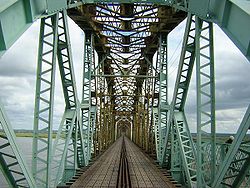- Dona Ana Bridge
-
The Dona Ana Bridge spans the lower Zambezi River between the towns of Vila de Sena and Mutarara in Mozambique, effectively linking the two halves of the country. Built by the Portuguese in 1934 during the Portuguese rule of Mozambique, and blown up by RENAMO soldiers during the Mozambican Civil War (1977-1992),[1] after independence from Portugal in 1975, it was originally constructed as a railway bridge to link Malawi and the Moatize coal fields to the port of Beira.
Contents
History
The 3.67km-long Dona Ana Bridge, at that time the longest railway bridge in Africa, was built by the Portuguese in 1935 during the Portuguese rule of Mozambique. In the 1980s, during the Mozambican Civil War, it was rendered unusable. In 1995, it was repaired with funds from USAID and converted to a single-lane bridge for vehicle traffic (as shown in the picture). Although not located on a primary highway, it provided an alternative route over the Zambezi; the only other two options were the bridge at Tete and the road ferry at Caia (which was not always reliable). The Dona Ana Bridge is the longest bridge to cross the Zambezi and was the last before its mouth in the Indian Ocean. However, in 2007, construction started on a bridge to replace the Caia ferry, which (though shorter) would become the last bridge before the mouth. The Caia bridge opened in August 2009. Dona Ana Bridge was closed to vehicular traffic on July 1, 2006, and work to reconvert it to a railway bridge were started, reopening for operation in October 2009.
The bridge comprises 33 spans of 80m and 7 spans of 50m. [2]
See also
- List of longest bridges in the world
References
- ^ Little Miss Moffat, http://www.travelafricamag.com - Travel Africa Magazine (7 April, 2009)
- ^ RailwaysAfrica May 2009, p10
External links
Coordinates: 17°26′29″S 35°03′16″E / 17.44139°S 35.05444°E
Categories:- Bridge (structure) stubs
- African building and structure stubs
- Mozambique stubs
- Bridges completed in 1935
- Bridges in Mozambique
- Bridges over the Zambezi River
Wikimedia Foundation. 2010.

